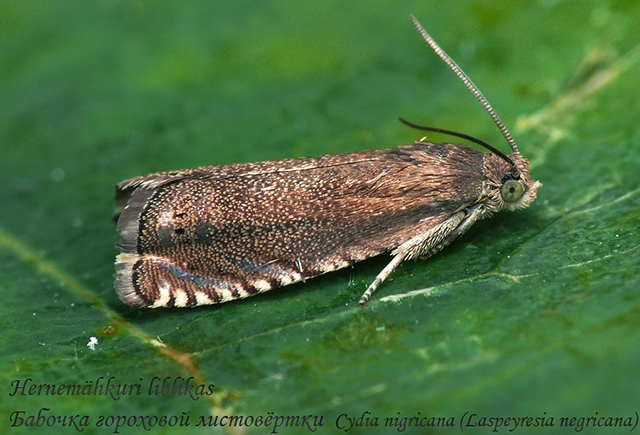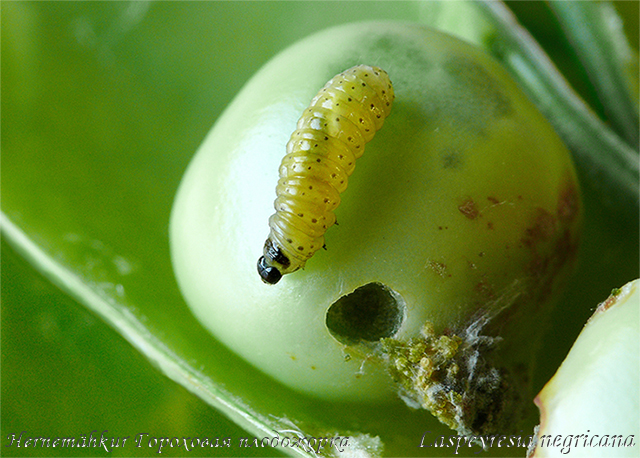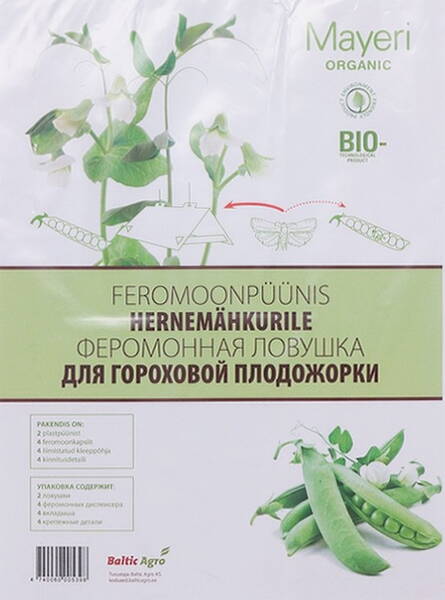Ex Tax: 7.85€
Target impact on a specific pest. Absolute harmlessness to humans, beneficial insects and the environment.
Designed to determine the numerical presence of a pest and its partial capture.
If the number of caught butterflies is more than 10 per day, then it is necessary to protect the plants with insecticides.
Application rate: 1 trap per 3 m of a bed of crops of legumes (peas, beans, lentils, etc.). On large plantations, traps can be used at intervals of up to 10 m.
Assembling the trap: bend the ends of the bottom of the trap up. Remove the backing paper and place the sheets on the bottom of the trap with glue up. Place a pheromone capsule in the middle of the adhesive sheets. Insert the fasteners and fasten the trap house horizontally.
Store the replacement capsule in a cool, dry place for future use.
Packaged:
2 plastic traps
4 capsules with pheromone
4 sheets of base with "undying" glue
4 fastening clasps.
NB! The glue is very sticky and cannot be washed off with water. You can wash your hands with regular rubbing alcohol, white spirit, or vegetable oil.

Rules for working with pheromone traps.
Despite the fact that synthetic pheromones are absolutely safe for humans and the environment, basic rules must be followed when working with them:
- pheromone dispensers are stored in a dry, dark place, out of the reach of children and pets, separately from food, medicine and feed.
- dispensers must be protected from moisture, foreign substances and direct sunlight.
- it is best to store them in tightly closed glass jars at a temperature of +3 +5°C.
- filling the traps with pheromone dispensers is done immediately before their use.
- after working with traps, wash your hands with soap.
- if glue gets on your hands while filling the traps with glue inserts, it can be easily removed with a swab moistened with alcohol or vegetable oil.
- traps made of laminated cardboard are disposed of, and plastic traps can be used in the next season.

Syn.: Cydia nigricana, Grapholita nigricana F.
* Harmful insects are constantly present in our gardens and vegetable gardens, but they are capable of causing significant damage to the crop only in the event of their critical number.
It is for this purpose that it is necessary to carry out monitoring - a systematic registration of the presence of pests, which is the most economical and accurate way of detecting and assessing the density of pest infestation of a site.
An effective tool is the use of pheromone traps, in which synthetic analogs of natural insect pheromones serve as bait.
An insect pheromone consists of a mixture of substances belonging to different classes of organic compounds: it can contain more than 10 components (alcohols, aldehydes, ethers, heterocyclic compounds, terpenoids, steroids, etc.)
Pheromone molecules are highly volatile, rapidly decomposing under the influence of oxygen, moisture and light.
The source of pheromone in insects is individual secretory cells scattered throughout the body or groups of them, forming a special organ - the pheromone gland.
Insects secrete pheromone in trace amounts: for example, the female codling moth (Cydia pomonella) releases only 9 nanograms of pheromone per hour - this amount is enough for the male to smell and find the female in the crown of the tree.
A male silkworm, for example, is able to distinguish a female pheromone at a concentration of 1 molecule per 1017 air molecules, with a capture rate of at least 1 molecule per second.
Insect pheromones are species-specific - they attract individuals only of their own species.
The biological purpose of insect pheromones is not the same: they are divided into sexual (promoting the convergence of individuals of opposite sexes during the breeding season), aggregation (ensuring the concentration of individuals of both sexes), trace, territorial, alarm pheromones, etc.
In socially organized insects (ants, bees, termites, etc.), pheromones coordinate the activities of all individuals of one family, maintaining its unity.
Having determined the chemical composition of the insect pheromone, it is possible to synthesize it under laboratory conditions - synthetic analogs of sex and aggregation pheromones are successfully used to protect plants from pests.












